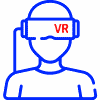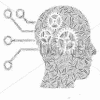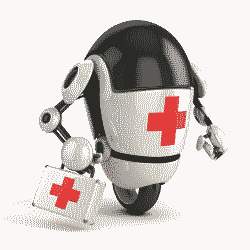THE RISING HEALTHCARE REVOLUTION
Are you afraid that robots will take over the jobs of nurses, doctors and other healthcare professionals?
WHAT DOES THE FUTURE LOOK LIKE?
Virtual reality
 VR is being used to train future surgeons and for actual surgeons to practice operations.
The technology is also benefiting patients and has been proven to be effective in pain management. Women are being equipped with VR headsets to visualize soothing landscapes so as to help them get through labour pain. Patients suffering from gastrointestinal, cardiac, neurological and post-surgical pain have shown a decline in their pain levels when using VR to distract them from painful stimuli.
VR is being used to train future surgeons and for actual surgeons to practice operations.
The technology is also benefiting patients and has been proven to be effective in pain management. Women are being equipped with VR headsets to visualize soothing landscapes so as to help them get through labour pain. Patients suffering from gastrointestinal, cardiac, neurological and post-surgical pain have shown a decline in their pain levels when using VR to distract them from painful stimuli.
Wearables and Sensors
 Wearable technologies can be innovative solutions for healthcare problems.
Wearable technologies enable the continuous monitoring of human physical activities and behaviors, as well as physiological and biochemical parameters during daily life. The most commonly measured data include vital signs such as heart rate, blood pressure, and body temperature, as well as blood oxygen saturation, posture, and physical activities through the use of electrocardiogram (ECG), ballistocardiogram (BCG) and other devices. Potentially, wearable photo or video devices could provide additional clinical information.
Wearable technologies can be innovative solutions for healthcare problems.
Wearable technologies enable the continuous monitoring of human physical activities and behaviors, as well as physiological and biochemical parameters during daily life. The most commonly measured data include vital signs such as heart rate, blood pressure, and body temperature, as well as blood oxygen saturation, posture, and physical activities through the use of electrocardiogram (ECG), ballistocardiogram (BCG) and other devices. Potentially, wearable photo or video devices could provide additional clinical information.
Robotics
 Advancements in medical technology are creating a world where robots may play a bigger part in healing the sick than doctors.
A future where robots help the aged live more independent. They can move around a room, you can talk to them and they will respond, and that’s important.
This robot can move around the house, adjust its height, it can take a cup of coffee from one room into another, it can remind you to take your medication and bring it to you from another room.
Advancements in medical technology are creating a world where robots may play a bigger part in healing the sick than doctors.
A future where robots help the aged live more independent. They can move around a room, you can talk to them and they will respond, and that’s important.
This robot can move around the house, adjust its height, it can take a cup of coffee from one room into another, it can remind you to take your medication and bring it to you from another room.
Remote Patient Monitoring
 Seeing a doctor for something relatively routine can be expensive. Not just in terms of your wallet, but also in terms of the time it takes for you to get to the doctor and for the doctor to fit you into their schedule.
Telemedicine has been in use for years to give people in remote places access to regular healthcare, but with ubiquitous streaming video and broadband connectivity, we’ll see its use increase as people get more and more comfortable with living and working remotely. For providers, it means that they can fit more patients in and give in-person patients more time.
Seeing a doctor for something relatively routine can be expensive. Not just in terms of your wallet, but also in terms of the time it takes for you to get to the doctor and for the doctor to fit you into their schedule.
Telemedicine has been in use for years to give people in remote places access to regular healthcare, but with ubiquitous streaming video and broadband connectivity, we’ll see its use increase as people get more and more comfortable with living and working remotely. For providers, it means that they can fit more patients in and give in-person patients more time.
Cyborgization
 Looking to the future, as our need to rapidly interface with computers and digital information continues to grow, it may make sense to leverage recent advances in neural interface technology. This concept, known as cyborgization, will let humans and machines work together seamlessly in a variety of contexts to deliver quality care in ways we never thought possible.
From providers being able to precisely control the movements of robotic surgical tools to patients who have integrated systems that track vital stats and warn of any impending trouble, the possibilities are endless.
Looking to the future, as our need to rapidly interface with computers and digital information continues to grow, it may make sense to leverage recent advances in neural interface technology. This concept, known as cyborgization, will let humans and machines work together seamlessly in a variety of contexts to deliver quality care in ways we never thought possible.
From providers being able to precisely control the movements of robotic surgical tools to patients who have integrated systems that track vital stats and warn of any impending trouble, the possibilities are endless.
Nanorobots
 The promises of nanotechnology are vast, but its reality may be here sooner than you think. A team of researchers from the US, Switzerland, and South Korea have already succeeded at creating nanorobots that can deliver drugs to soften clogged arteries, and then drill through the blockage.
Controlled by an MRI machine, this technology looks to have wide-ranging applications, but there’s a little more that needs to get worked out in the lab before they can move on to human test subjects.
The promises of nanotechnology are vast, but its reality may be here sooner than you think. A team of researchers from the US, Switzerland, and South Korea have already succeeded at creating nanorobots that can deliver drugs to soften clogged arteries, and then drill through the blockage.
Controlled by an MRI machine, this technology looks to have wide-ranging applications, but there’s a little more that needs to get worked out in the lab before they can move on to human test subjects.
WELCOME TO THE FUTURE

Advances in future medical technology will not just repair physical disadvantages such as impaired eyesight but will also create superhuman powers from having the eyesight of an eagle to possessing the hearing of a bat.
